MNG932002: Analyzing Netflix's Strategic Victory Over Blockbuster
VerifiedAdded on 2024/06/03
|17
|3519
|387
Case Study
AI Summary
This case study provides a comparative analysis of Blockbuster and Netflix, detailing their histories and market positions. It examines the factors contributing to Netflix's success over Blockbuster, including technological changes, pricing strategies, and innovative approaches like online streaming and DVD rentals by mail. The study also explores Netflix's challenges, such as the Qwikster failure, and its subsequent focus on original content. Ultimately, it assesses Netflix's future prospects in the evolving online video streaming landscape. This resource is available on Desklib, where students can find more past papers and solved assignments.
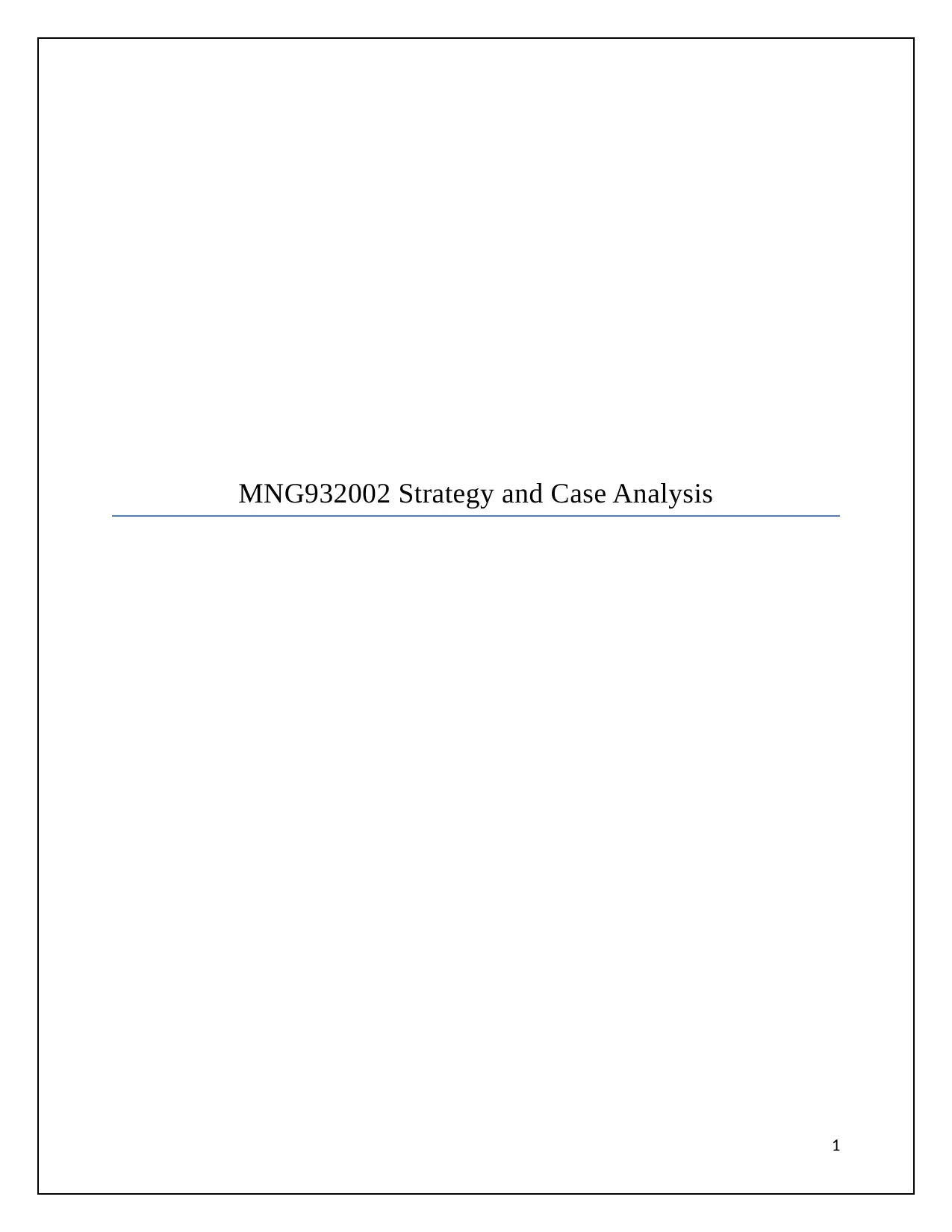
MNG932002 Strategy and Case Analysis
1
1
Paraphrase This Document
Need a fresh take? Get an instant paraphrase of this document with our AI Paraphraser

Contents
1. Introduction.............................................................................................................................................3
2. Institutional Background.........................................................................................................................4
2.1: A brief history of Blockbuster..........................................................................................................4
2.2: A brief history of Netflix..................................................................................................................6
3: How Netflix beat Blockbuster.................................................................................................................7
3.1. Changing technology........................................................................................................................7
3.2. Retail outlets versus operating online...............................................................................................8
3.3. Pricing strategies..............................................................................................................................9
3.4. Netflix’s innovations......................................................................................................................11
4. Will Netflix remain the dominant provider of online video streaming?.................................................12
4.1. Netflix stumbles: The demise of Qwikster......................................................................................12
4.2. Netflix rebuilds: The rise of original content..................................................................................13
4.3. The future of Netflix.......................................................................................................................14
5. Conclusion.............................................................................................................................................15
References.................................................................................................................................................16
2
1. Introduction.............................................................................................................................................3
2. Institutional Background.........................................................................................................................4
2.1: A brief history of Blockbuster..........................................................................................................4
2.2: A brief history of Netflix..................................................................................................................6
3: How Netflix beat Blockbuster.................................................................................................................7
3.1. Changing technology........................................................................................................................7
3.2. Retail outlets versus operating online...............................................................................................8
3.3. Pricing strategies..............................................................................................................................9
3.4. Netflix’s innovations......................................................................................................................11
4. Will Netflix remain the dominant provider of online video streaming?.................................................12
4.1. Netflix stumbles: The demise of Qwikster......................................................................................12
4.2. Netflix rebuilds: The rise of original content..................................................................................13
4.3. The future of Netflix.......................................................................................................................14
5. Conclusion.............................................................................................................................................15
References.................................................................................................................................................16
2
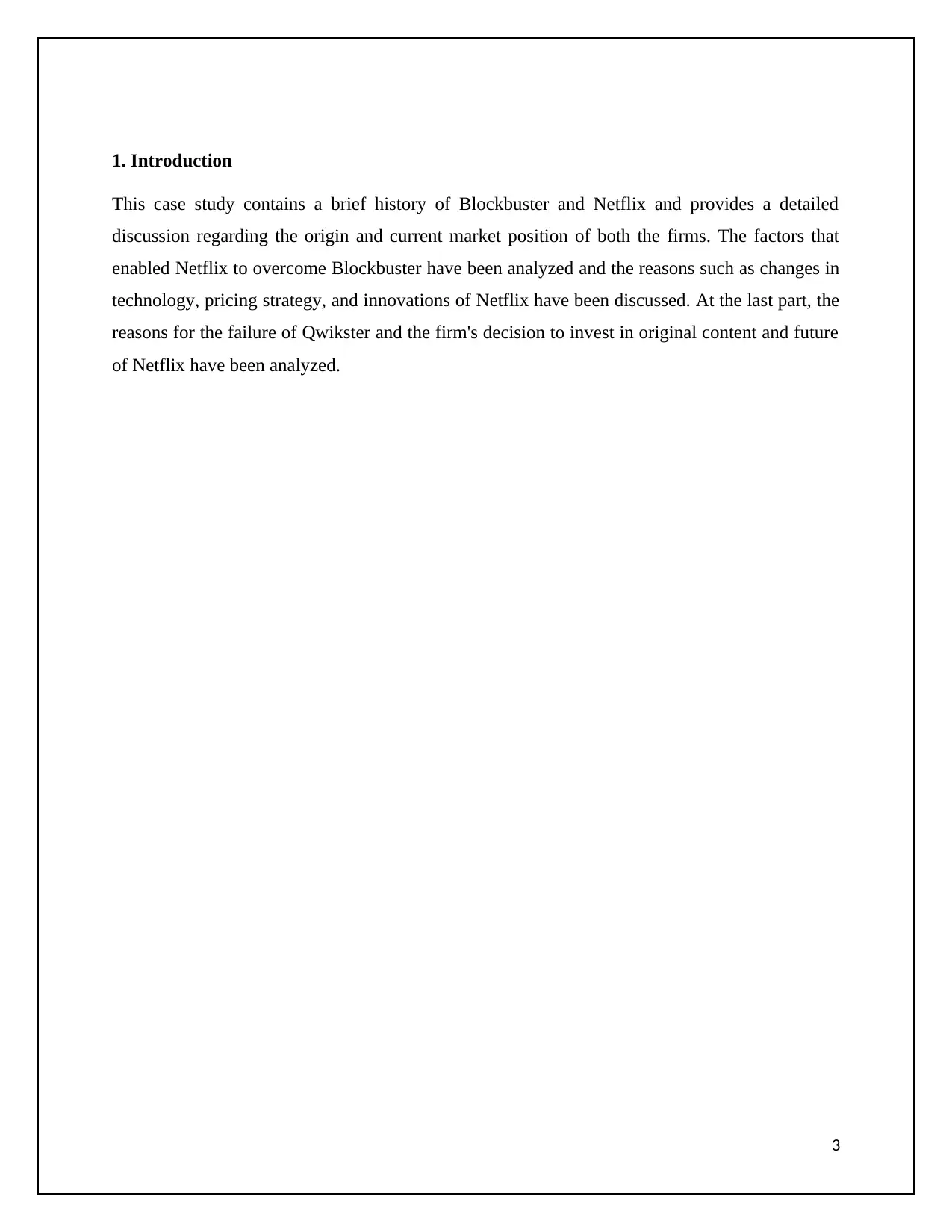
1. Introduction
This case study contains a brief history of Blockbuster and Netflix and provides a detailed
discussion regarding the origin and current market position of both the firms. The factors that
enabled Netflix to overcome Blockbuster have been analyzed and the reasons such as changes in
technology, pricing strategy, and innovations of Netflix have been discussed. At the last part, the
reasons for the failure of Qwikster and the firm's decision to invest in original content and future
of Netflix have been analyzed.
3
This case study contains a brief history of Blockbuster and Netflix and provides a detailed
discussion regarding the origin and current market position of both the firms. The factors that
enabled Netflix to overcome Blockbuster have been analyzed and the reasons such as changes in
technology, pricing strategy, and innovations of Netflix have been discussed. At the last part, the
reasons for the failure of Qwikster and the firm's decision to invest in original content and future
of Netflix have been analyzed.
3
⊘ This is a preview!⊘
Do you want full access?
Subscribe today to unlock all pages.

Trusted by 1+ million students worldwide
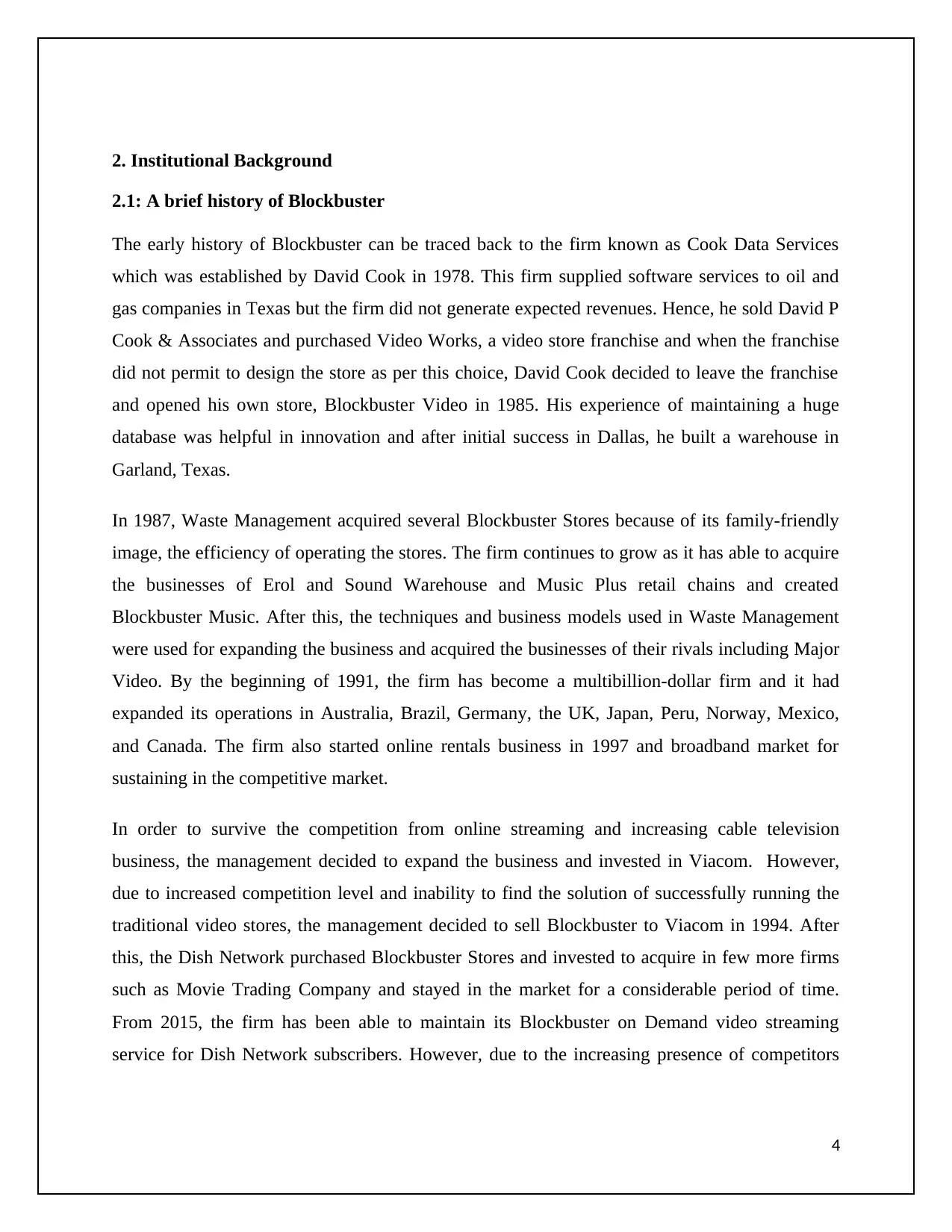
2. Institutional Background
2.1: A brief history of Blockbuster
The early history of Blockbuster can be traced back to the firm known as Cook Data Services
which was established by David Cook in 1978. This firm supplied software services to oil and
gas companies in Texas but the firm did not generate expected revenues. Hence, he sold David P
Cook & Associates and purchased Video Works, a video store franchise and when the franchise
did not permit to design the store as per this choice, David Cook decided to leave the franchise
and opened his own store, Blockbuster Video in 1985. His experience of maintaining a huge
database was helpful in innovation and after initial success in Dallas, he built a warehouse in
Garland, Texas.
In 1987, Waste Management acquired several Blockbuster Stores because of its family-friendly
image, the efficiency of operating the stores. The firm continues to grow as it has able to acquire
the businesses of Erol and Sound Warehouse and Music Plus retail chains and created
Blockbuster Music. After this, the techniques and business models used in Waste Management
were used for expanding the business and acquired the businesses of their rivals including Major
Video. By the beginning of 1991, the firm has become a multibillion-dollar firm and it had
expanded its operations in Australia, Brazil, Germany, the UK, Japan, Peru, Norway, Mexico,
and Canada. The firm also started online rentals business in 1997 and broadband market for
sustaining in the competitive market.
In order to survive the competition from online streaming and increasing cable television
business, the management decided to expand the business and invested in Viacom. However,
due to increased competition level and inability to find the solution of successfully running the
traditional video stores, the management decided to sell Blockbuster to Viacom in 1994. After
this, the Dish Network purchased Blockbuster Stores and invested to acquire in few more firms
such as Movie Trading Company and stayed in the market for a considerable period of time.
From 2015, the firm has been able to maintain its Blockbuster on Demand video streaming
service for Dish Network subscribers. However, due to the increasing presence of competitors
4
2.1: A brief history of Blockbuster
The early history of Blockbuster can be traced back to the firm known as Cook Data Services
which was established by David Cook in 1978. This firm supplied software services to oil and
gas companies in Texas but the firm did not generate expected revenues. Hence, he sold David P
Cook & Associates and purchased Video Works, a video store franchise and when the franchise
did not permit to design the store as per this choice, David Cook decided to leave the franchise
and opened his own store, Blockbuster Video in 1985. His experience of maintaining a huge
database was helpful in innovation and after initial success in Dallas, he built a warehouse in
Garland, Texas.
In 1987, Waste Management acquired several Blockbuster Stores because of its family-friendly
image, the efficiency of operating the stores. The firm continues to grow as it has able to acquire
the businesses of Erol and Sound Warehouse and Music Plus retail chains and created
Blockbuster Music. After this, the techniques and business models used in Waste Management
were used for expanding the business and acquired the businesses of their rivals including Major
Video. By the beginning of 1991, the firm has become a multibillion-dollar firm and it had
expanded its operations in Australia, Brazil, Germany, the UK, Japan, Peru, Norway, Mexico,
and Canada. The firm also started online rentals business in 1997 and broadband market for
sustaining in the competitive market.
In order to survive the competition from online streaming and increasing cable television
business, the management decided to expand the business and invested in Viacom. However,
due to increased competition level and inability to find the solution of successfully running the
traditional video stores, the management decided to sell Blockbuster to Viacom in 1994. After
this, the Dish Network purchased Blockbuster Stores and invested to acquire in few more firms
such as Movie Trading Company and stayed in the market for a considerable period of time.
From 2015, the firm has been able to maintain its Blockbuster on Demand video streaming
service for Dish Network subscribers. However, due to the increasing presence of competitors
4
Paraphrase This Document
Need a fresh take? Get an instant paraphrase of this document with our AI Paraphraser

such as Netflix, Redbox, and video on demand services, the firm's business continues to decline
and Dish Network still maintains few Blockbuster franchise.
Figure 1: Demise of Blockbuster
Source: (Korsgaard, 2013).
5
and Dish Network still maintains few Blockbuster franchise.
Figure 1: Demise of Blockbuster
Source: (Korsgaard, 2013).
5
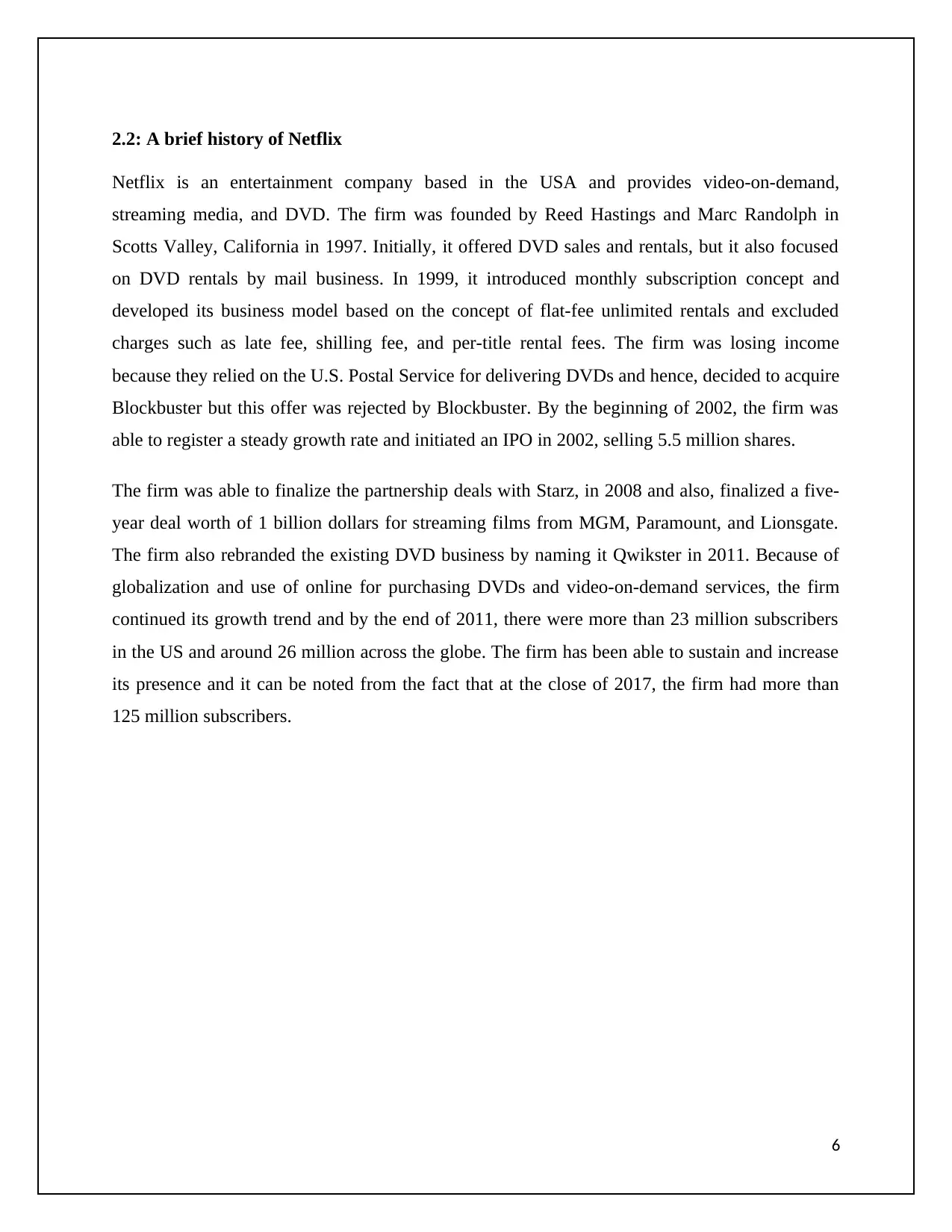
2.2: A brief history of Netflix
Netflix is an entertainment company based in the USA and provides video-on-demand,
streaming media, and DVD. The firm was founded by Reed Hastings and Marc Randolph in
Scotts Valley, California in 1997. Initially, it offered DVD sales and rentals, but it also focused
on DVD rentals by mail business. In 1999, it introduced monthly subscription concept and
developed its business model based on the concept of flat-fee unlimited rentals and excluded
charges such as late fee, shilling fee, and per-title rental fees. The firm was losing income
because they relied on the U.S. Postal Service for delivering DVDs and hence, decided to acquire
Blockbuster but this offer was rejected by Blockbuster. By the beginning of 2002, the firm was
able to register a steady growth rate and initiated an IPO in 2002, selling 5.5 million shares.
The firm was able to finalize the partnership deals with Starz, in 2008 and also, finalized a five-
year deal worth of 1 billion dollars for streaming films from MGM, Paramount, and Lionsgate.
The firm also rebranded the existing DVD business by naming it Qwikster in 2011. Because of
globalization and use of online for purchasing DVDs and video-on-demand services, the firm
continued its growth trend and by the end of 2011, there were more than 23 million subscribers
in the US and around 26 million across the globe. The firm has been able to sustain and increase
its presence and it can be noted from the fact that at the close of 2017, the firm had more than
125 million subscribers.
6
Netflix is an entertainment company based in the USA and provides video-on-demand,
streaming media, and DVD. The firm was founded by Reed Hastings and Marc Randolph in
Scotts Valley, California in 1997. Initially, it offered DVD sales and rentals, but it also focused
on DVD rentals by mail business. In 1999, it introduced monthly subscription concept and
developed its business model based on the concept of flat-fee unlimited rentals and excluded
charges such as late fee, shilling fee, and per-title rental fees. The firm was losing income
because they relied on the U.S. Postal Service for delivering DVDs and hence, decided to acquire
Blockbuster but this offer was rejected by Blockbuster. By the beginning of 2002, the firm was
able to register a steady growth rate and initiated an IPO in 2002, selling 5.5 million shares.
The firm was able to finalize the partnership deals with Starz, in 2008 and also, finalized a five-
year deal worth of 1 billion dollars for streaming films from MGM, Paramount, and Lionsgate.
The firm also rebranded the existing DVD business by naming it Qwikster in 2011. Because of
globalization and use of online for purchasing DVDs and video-on-demand services, the firm
continued its growth trend and by the end of 2011, there were more than 23 million subscribers
in the US and around 26 million across the globe. The firm has been able to sustain and increase
its presence and it can be noted from the fact that at the close of 2017, the firm had more than
125 million subscribers.
6
⊘ This is a preview!⊘
Do you want full access?
Subscribe today to unlock all pages.

Trusted by 1+ million students worldwide
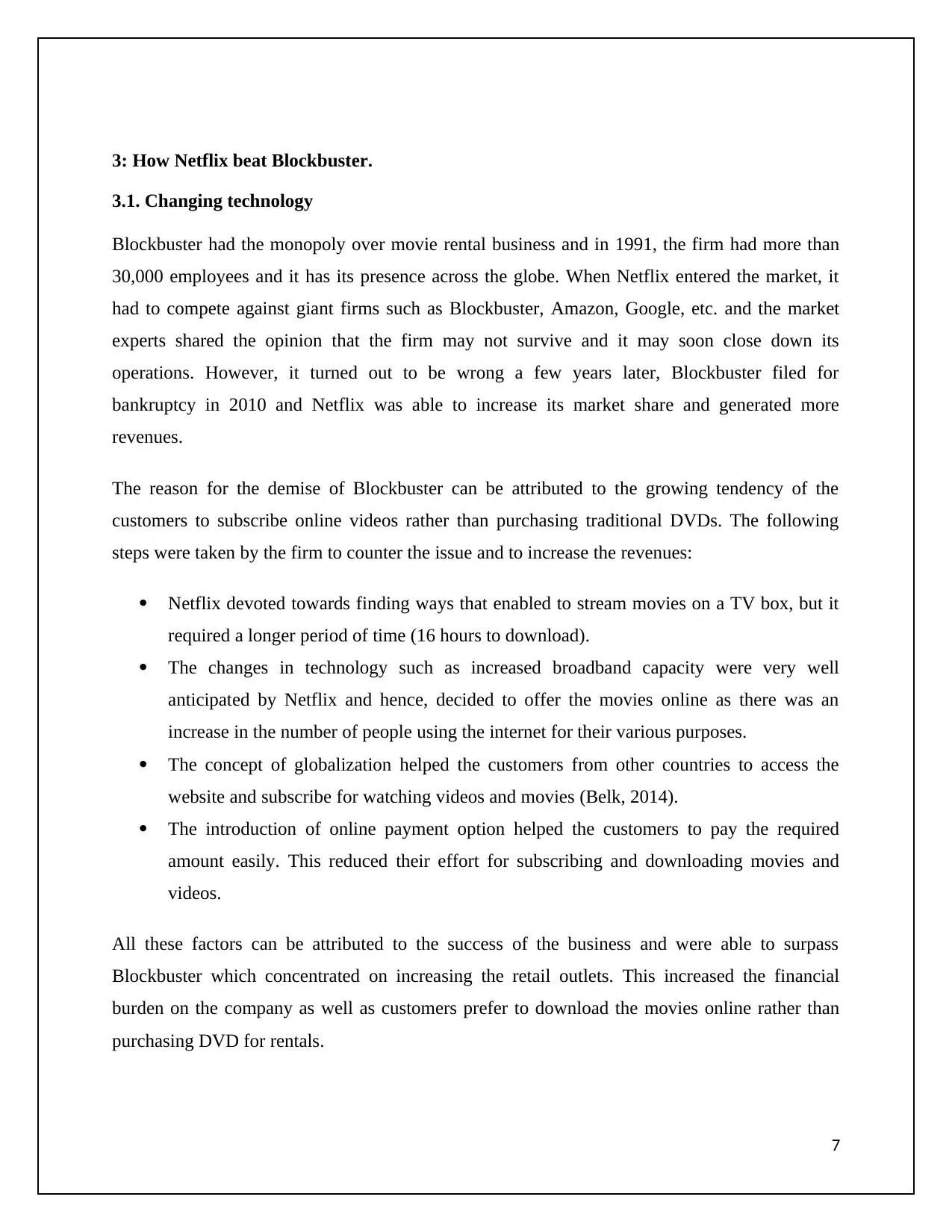
3: How Netflix beat Blockbuster.
3.1. Changing technology
Blockbuster had the monopoly over movie rental business and in 1991, the firm had more than
30,000 employees and it has its presence across the globe. When Netflix entered the market, it
had to compete against giant firms such as Blockbuster, Amazon, Google, etc. and the market
experts shared the opinion that the firm may not survive and it may soon close down its
operations. However, it turned out to be wrong a few years later, Blockbuster filed for
bankruptcy in 2010 and Netflix was able to increase its market share and generated more
revenues.
The reason for the demise of Blockbuster can be attributed to the growing tendency of the
customers to subscribe online videos rather than purchasing traditional DVDs. The following
steps were taken by the firm to counter the issue and to increase the revenues:
Netflix devoted towards finding ways that enabled to stream movies on a TV box, but it
required a longer period of time (16 hours to download).
The changes in technology such as increased broadband capacity were very well
anticipated by Netflix and hence, decided to offer the movies online as there was an
increase in the number of people using the internet for their various purposes.
The concept of globalization helped the customers from other countries to access the
website and subscribe for watching videos and movies (Belk, 2014).
The introduction of online payment option helped the customers to pay the required
amount easily. This reduced their effort for subscribing and downloading movies and
videos.
All these factors can be attributed to the success of the business and were able to surpass
Blockbuster which concentrated on increasing the retail outlets. This increased the financial
burden on the company as well as customers prefer to download the movies online rather than
purchasing DVD for rentals.
7
3.1. Changing technology
Blockbuster had the monopoly over movie rental business and in 1991, the firm had more than
30,000 employees and it has its presence across the globe. When Netflix entered the market, it
had to compete against giant firms such as Blockbuster, Amazon, Google, etc. and the market
experts shared the opinion that the firm may not survive and it may soon close down its
operations. However, it turned out to be wrong a few years later, Blockbuster filed for
bankruptcy in 2010 and Netflix was able to increase its market share and generated more
revenues.
The reason for the demise of Blockbuster can be attributed to the growing tendency of the
customers to subscribe online videos rather than purchasing traditional DVDs. The following
steps were taken by the firm to counter the issue and to increase the revenues:
Netflix devoted towards finding ways that enabled to stream movies on a TV box, but it
required a longer period of time (16 hours to download).
The changes in technology such as increased broadband capacity were very well
anticipated by Netflix and hence, decided to offer the movies online as there was an
increase in the number of people using the internet for their various purposes.
The concept of globalization helped the customers from other countries to access the
website and subscribe for watching videos and movies (Belk, 2014).
The introduction of online payment option helped the customers to pay the required
amount easily. This reduced their effort for subscribing and downloading movies and
videos.
All these factors can be attributed to the success of the business and were able to surpass
Blockbuster which concentrated on increasing the retail outlets. This increased the financial
burden on the company as well as customers prefer to download the movies online rather than
purchasing DVD for rentals.
7
Paraphrase This Document
Need a fresh take? Get an instant paraphrase of this document with our AI Paraphraser
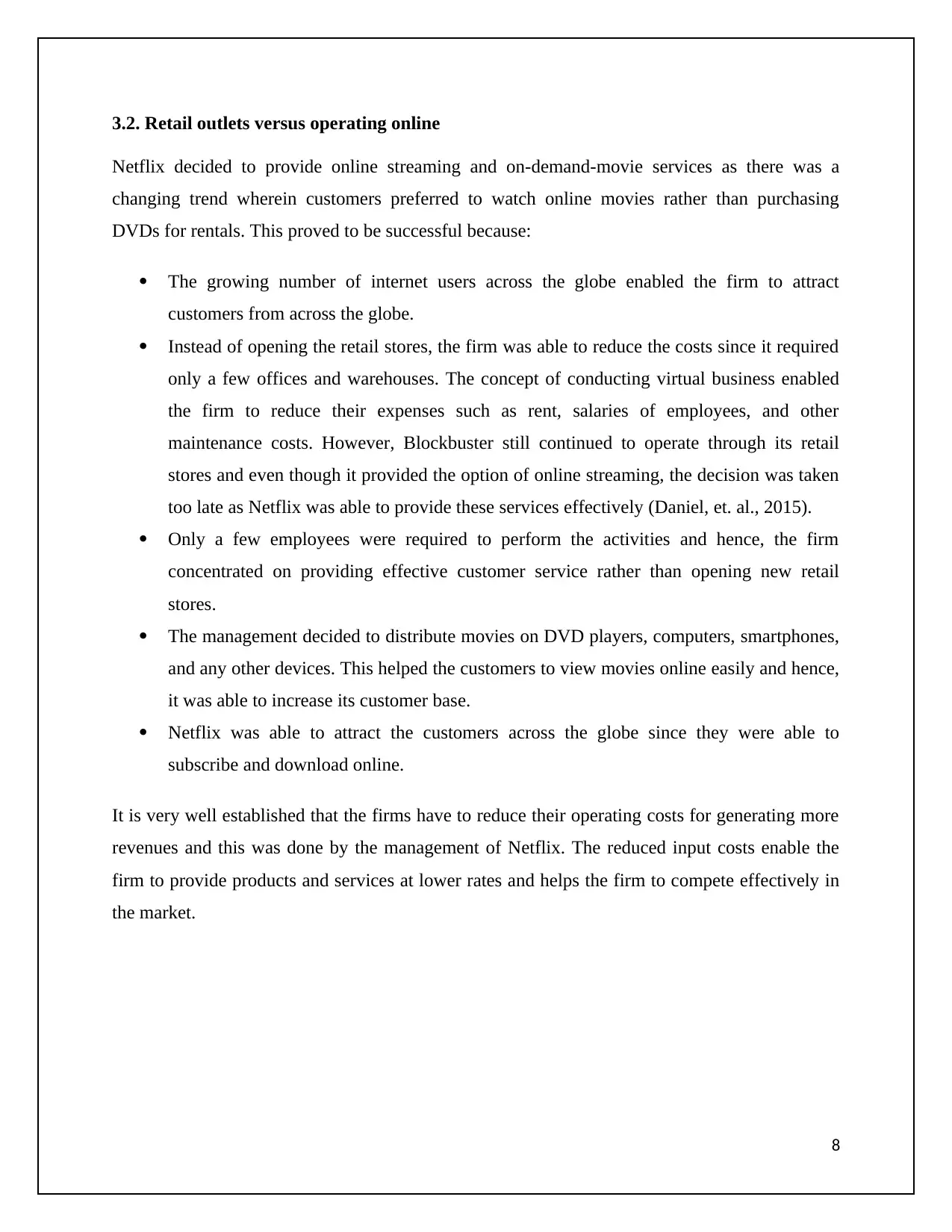
3.2. Retail outlets versus operating online
Netflix decided to provide online streaming and on-demand-movie services as there was a
changing trend wherein customers preferred to watch online movies rather than purchasing
DVDs for rentals. This proved to be successful because:
The growing number of internet users across the globe enabled the firm to attract
customers from across the globe.
Instead of opening the retail stores, the firm was able to reduce the costs since it required
only a few offices and warehouses. The concept of conducting virtual business enabled
the firm to reduce their expenses such as rent, salaries of employees, and other
maintenance costs. However, Blockbuster still continued to operate through its retail
stores and even though it provided the option of online streaming, the decision was taken
too late as Netflix was able to provide these services effectively (Daniel, et. al., 2015).
Only a few employees were required to perform the activities and hence, the firm
concentrated on providing effective customer service rather than opening new retail
stores.
The management decided to distribute movies on DVD players, computers, smartphones,
and any other devices. This helped the customers to view movies online easily and hence,
it was able to increase its customer base.
Netflix was able to attract the customers across the globe since they were able to
subscribe and download online.
It is very well established that the firms have to reduce their operating costs for generating more
revenues and this was done by the management of Netflix. The reduced input costs enable the
firm to provide products and services at lower rates and helps the firm to compete effectively in
the market.
8
Netflix decided to provide online streaming and on-demand-movie services as there was a
changing trend wherein customers preferred to watch online movies rather than purchasing
DVDs for rentals. This proved to be successful because:
The growing number of internet users across the globe enabled the firm to attract
customers from across the globe.
Instead of opening the retail stores, the firm was able to reduce the costs since it required
only a few offices and warehouses. The concept of conducting virtual business enabled
the firm to reduce their expenses such as rent, salaries of employees, and other
maintenance costs. However, Blockbuster still continued to operate through its retail
stores and even though it provided the option of online streaming, the decision was taken
too late as Netflix was able to provide these services effectively (Daniel, et. al., 2015).
Only a few employees were required to perform the activities and hence, the firm
concentrated on providing effective customer service rather than opening new retail
stores.
The management decided to distribute movies on DVD players, computers, smartphones,
and any other devices. This helped the customers to view movies online easily and hence,
it was able to increase its customer base.
Netflix was able to attract the customers across the globe since they were able to
subscribe and download online.
It is very well established that the firms have to reduce their operating costs for generating more
revenues and this was done by the management of Netflix. The reduced input costs enable the
firm to provide products and services at lower rates and helps the firm to compete effectively in
the market.
8

3.3. Pricing strategies
Pricing is one of the important strategies which enables the firms to enhance their
competitiveness and enables the firms to attract customers. Pricing decides the future course of
business as the customers expect to purchase the goods and services at lower costs by
maintaining the quality of the services (Hinterhuber, et. al., 2014). The pricing strategy of Netflix
can be illustrated as given below:
Netflix considered excluding certain charges such as late fee, shilling fee, and per-title
rental fees which helped to increase the customer base. However, these charges remained
to be the main source of income for Blockbuster and hence, the firm continues to charge
the customers.
Netflix also revised its pricing strategy by introducing the concept of monthly
subscription along with offering free movie download option to the subscribers. This new
concept attracted customers to utilise the facility provided to them. Whereas, Blockbuster
continue to charge customers for per movie download which increased the amount of
downloading the videos and movies by the customers (Satell, 2014).
Netflix also considered reviewing its ratings by the feedback provided by the customers
and continuously upgrade its website so that the videos and movies can be downloaded
easily and at a faster rate.
9
Pricing is one of the important strategies which enables the firms to enhance their
competitiveness and enables the firms to attract customers. Pricing decides the future course of
business as the customers expect to purchase the goods and services at lower costs by
maintaining the quality of the services (Hinterhuber, et. al., 2014). The pricing strategy of Netflix
can be illustrated as given below:
Netflix considered excluding certain charges such as late fee, shilling fee, and per-title
rental fees which helped to increase the customer base. However, these charges remained
to be the main source of income for Blockbuster and hence, the firm continues to charge
the customers.
Netflix also revised its pricing strategy by introducing the concept of monthly
subscription along with offering free movie download option to the subscribers. This new
concept attracted customers to utilise the facility provided to them. Whereas, Blockbuster
continue to charge customers for per movie download which increased the amount of
downloading the videos and movies by the customers (Satell, 2014).
Netflix also considered reviewing its ratings by the feedback provided by the customers
and continuously upgrade its website so that the videos and movies can be downloaded
easily and at a faster rate.
9
⊘ This is a preview!⊘
Do you want full access?
Subscribe today to unlock all pages.

Trusted by 1+ million students worldwide

Figure 2: Netflix’s Pricing Strategy
Source: (Ritcher, 2017)
Hence, Netflix was able to develop the strategies by understanding the changes in the
preferences of the customers, whereas, Blockbuster still considered to conduct the business based
on the concept of providing services at higher costs. Because of its financial condition,
Blockbuster was forced to charge more which reduced its competitiveness and hence, this
resulted in generating fewer revenues and filed for bankruptcy.
10
Source: (Ritcher, 2017)
Hence, Netflix was able to develop the strategies by understanding the changes in the
preferences of the customers, whereas, Blockbuster still considered to conduct the business based
on the concept of providing services at higher costs. Because of its financial condition,
Blockbuster was forced to charge more which reduced its competitiveness and hence, this
resulted in generating fewer revenues and filed for bankruptcy.
10
Paraphrase This Document
Need a fresh take? Get an instant paraphrase of this document with our AI Paraphraser
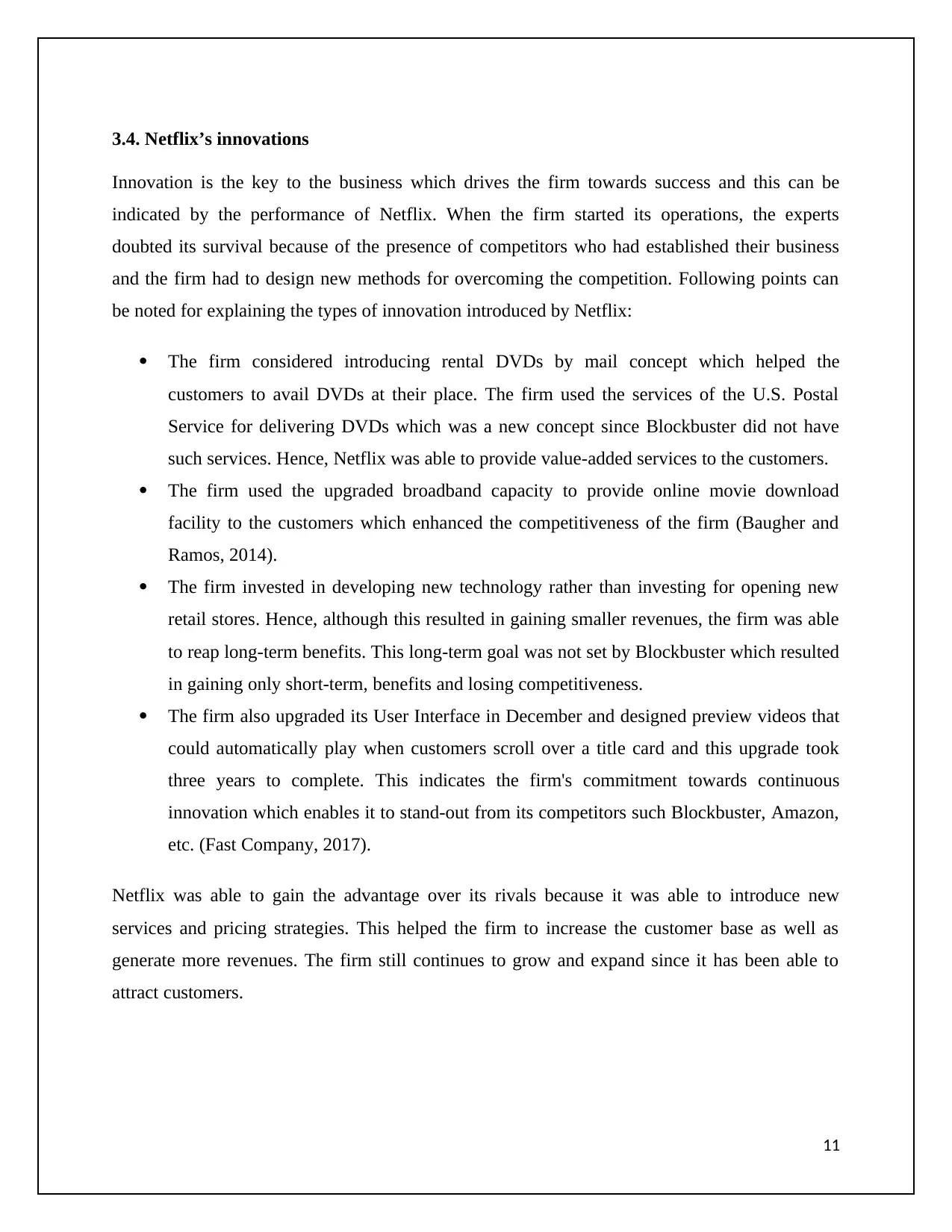
3.4. Netflix’s innovations
Innovation is the key to the business which drives the firm towards success and this can be
indicated by the performance of Netflix. When the firm started its operations, the experts
doubted its survival because of the presence of competitors who had established their business
and the firm had to design new methods for overcoming the competition. Following points can
be noted for explaining the types of innovation introduced by Netflix:
The firm considered introducing rental DVDs by mail concept which helped the
customers to avail DVDs at their place. The firm used the services of the U.S. Postal
Service for delivering DVDs which was a new concept since Blockbuster did not have
such services. Hence, Netflix was able to provide value-added services to the customers.
The firm used the upgraded broadband capacity to provide online movie download
facility to the customers which enhanced the competitiveness of the firm (Baugher and
Ramos, 2014).
The firm invested in developing new technology rather than investing for opening new
retail stores. Hence, although this resulted in gaining smaller revenues, the firm was able
to reap long-term benefits. This long-term goal was not set by Blockbuster which resulted
in gaining only short-term, benefits and losing competitiveness.
The firm also upgraded its User Interface in December and designed preview videos that
could automatically play when customers scroll over a title card and this upgrade took
three years to complete. This indicates the firm's commitment towards continuous
innovation which enables it to stand-out from its competitors such Blockbuster, Amazon,
etc. (Fast Company, 2017).
Netflix was able to gain the advantage over its rivals because it was able to introduce new
services and pricing strategies. This helped the firm to increase the customer base as well as
generate more revenues. The firm still continues to grow and expand since it has been able to
attract customers.
11
Innovation is the key to the business which drives the firm towards success and this can be
indicated by the performance of Netflix. When the firm started its operations, the experts
doubted its survival because of the presence of competitors who had established their business
and the firm had to design new methods for overcoming the competition. Following points can
be noted for explaining the types of innovation introduced by Netflix:
The firm considered introducing rental DVDs by mail concept which helped the
customers to avail DVDs at their place. The firm used the services of the U.S. Postal
Service for delivering DVDs which was a new concept since Blockbuster did not have
such services. Hence, Netflix was able to provide value-added services to the customers.
The firm used the upgraded broadband capacity to provide online movie download
facility to the customers which enhanced the competitiveness of the firm (Baugher and
Ramos, 2014).
The firm invested in developing new technology rather than investing for opening new
retail stores. Hence, although this resulted in gaining smaller revenues, the firm was able
to reap long-term benefits. This long-term goal was not set by Blockbuster which resulted
in gaining only short-term, benefits and losing competitiveness.
The firm also upgraded its User Interface in December and designed preview videos that
could automatically play when customers scroll over a title card and this upgrade took
three years to complete. This indicates the firm's commitment towards continuous
innovation which enables it to stand-out from its competitors such Blockbuster, Amazon,
etc. (Fast Company, 2017).
Netflix was able to gain the advantage over its rivals because it was able to introduce new
services and pricing strategies. This helped the firm to increase the customer base as well as
generate more revenues. The firm still continues to grow and expand since it has been able to
attract customers.
11

4. Will Netflix remain the dominant provider of online video streaming?
4.1. Netflix stumbles: The demise of Qwikster
The decision for expanding the current market share prompted Netflix to introduce Qwickster, a
separate entity identified by different names such as Twitter, Napster, etc. This was done as part
of changes in the operations and to ease the performance of activities by decentralising the core
activities. The concept was to form a new entity for providing online streaming and DVD rental
services and to charge separate charges for availing these services.
However, there was confusion among the customers because of this new arrangement because:
There were two domains created namely Netflix.com and Qwikster.com and these two
websites were not integrated, hence, the user had to enter the information twice for
providing billing information.
Also, the ratings provided by the customer in Qwikster could not be viewed in Netflix
and vice versa.
The introduction of separate costs for online streaming and DVD rentals resulted in
increased costs over 60% of the earlier pricing strategy. For example, the firm decided to
discontinue US$9.99 monthly rental services and replace it with charging US$7.99 for
streaming and US$7.99 for online DVD at a time (E-Commerce Times, 2017).
This decision resulted in many customers unsubscribing from the monthly rental services and
there was a considerable drop in the number of customers visiting Netflix website. Hence, the
management decided to stop the above plans and decided to close Qwikster after receiving
negative feedback from the customers.
12
4.1. Netflix stumbles: The demise of Qwikster
The decision for expanding the current market share prompted Netflix to introduce Qwickster, a
separate entity identified by different names such as Twitter, Napster, etc. This was done as part
of changes in the operations and to ease the performance of activities by decentralising the core
activities. The concept was to form a new entity for providing online streaming and DVD rental
services and to charge separate charges for availing these services.
However, there was confusion among the customers because of this new arrangement because:
There were two domains created namely Netflix.com and Qwikster.com and these two
websites were not integrated, hence, the user had to enter the information twice for
providing billing information.
Also, the ratings provided by the customer in Qwikster could not be viewed in Netflix
and vice versa.
The introduction of separate costs for online streaming and DVD rentals resulted in
increased costs over 60% of the earlier pricing strategy. For example, the firm decided to
discontinue US$9.99 monthly rental services and replace it with charging US$7.99 for
streaming and US$7.99 for online DVD at a time (E-Commerce Times, 2017).
This decision resulted in many customers unsubscribing from the monthly rental services and
there was a considerable drop in the number of customers visiting Netflix website. Hence, the
management decided to stop the above plans and decided to close Qwikster after receiving
negative feedback from the customers.
12
⊘ This is a preview!⊘
Do you want full access?
Subscribe today to unlock all pages.

Trusted by 1+ million students worldwide
1 out of 17
Related Documents
Your All-in-One AI-Powered Toolkit for Academic Success.
+13062052269
info@desklib.com
Available 24*7 on WhatsApp / Email
![[object Object]](/_next/static/media/star-bottom.7253800d.svg)
Unlock your academic potential
Copyright © 2020–2025 A2Z Services. All Rights Reserved. Developed and managed by ZUCOL.




